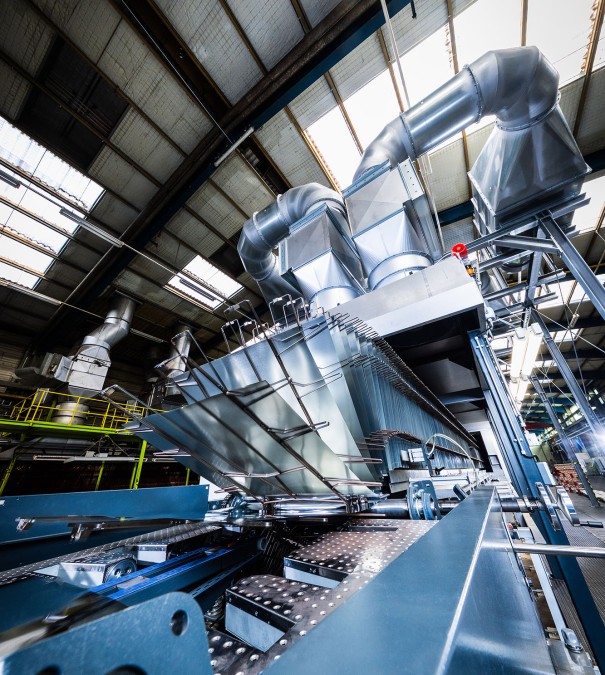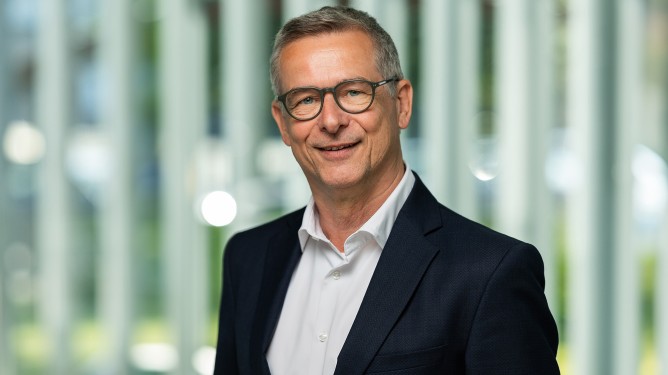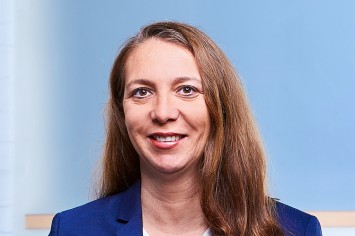Packaging steel runs in circles
Mr. Hoffmann, what sustainability vision guides thyssenkrupp Rasselstein, and what role do innovation and efficiency in production processes play in achieving them?
Oliver Hoffmann: Our sustainability vision is holistic. We ensure that the environment, our customers, our employees, and ultimately the end consumer benefit from our packaging steel through increasingly climate-friendly and efficient production, consistent focus on the circular economy, and the highest standards in occupational health and safety. To achieve this holistic sustainability goal, continuous modernization of our technologies and production processes is essential. Only then can we ensure steadily improving economic, environmental, and social performance for our customers and ourselves.
To this end, we consistently take a holistic view of packaging steel and related products such as food and aerosol cans. We use life cycle assessments (LCAs) to track the entire process, from the extraction of primary resources to the recycling of our packaging steel into new steel products.
Packaging manufacturers strive for efficiency gains. In which areas is thyssenkrupp Rasselstein focusing its innovations to achieve them?
Oliver Hoffmann: Efficiency gains can be achieved specifically by improving our tinplate products. With the development of rasselstein® Solidflex, we created an entirely new product family that enables the production of packaging steel using fewer resources without compromising performance. This technology allows us to make the material both stronger and more formable, enabling the manufacture of thinner and lighter food and aerosol cans. Using less material while maintaining stability represents a significant efficiency gain that conserves resources and reduces CO2 emissions. Thus, we enable our customers to achieve notable reductions in their Scope 3 emissions.
Are there additional process-related developments currently under research?
Oliver Hoffmann: One particularly exciting EU-funded project in process innovation is Roll-Oil-free. We are investigating whether a long-term alternative to conventional rolling oil can be found. Ideally, the substance would also have a cleaning effect, which could simplify or even eliminate the need for subsequent degreasing, making it a highly promising approach in terms of sustainability.
In recent years, thyssenkrupp Rasselstein has increasingly embraced digital solutions. How are efficiency and digitalization connected?
Oliver Hoffmann: thyssenkrupp Rasselstein is progressively digitalizing its processes and developing proprietary applications. To accelerate this transformation, we established the Digital Solutions division about two years ago. This is where our experts create innovative IT solutions that support customers while making supply chains, products, and production processes more efficient and transparent. Time and again, we demonstrate that the future of packaging steel is modern, digital, and sustainable.
Thanks to digital tools, we can identify opportunities for resource savings and efficiency improvements even before a product is physically produced. Using the finite element analysis (FEA), can manufacturers are able to comprehensively test the feasibility of new geometries and material reductions in a virtual environment before practical application. FEA-supported development of new packaging steel grades enables precise gauge reductions, which not only save valuable resources but also reduce CO2 emissions during transport. FEA also opens up a wide range of opportunities for product innovation in the packaging sector. Manufacturers can take bolder steps and explore more creative solutions. Throughout these processes, we provide guidance to our customers to jointly develop the best applications for sustainable, modern packaging. To make this process as streamlined and user-friendly as possible, we developed an intuitive application that allows customers, in collaboration with our Technical Customer Service team, to digitally model a can on a tablet and adjust material parameters with just a few clicks. This enables simulation of optimal geometry and material thickness in a short amount of time, tailored to the selected packaging steel grade.
Mr. Hoffmann, at the beginning you mentioned that thyssenkrupp Rasselstein's sustainability goals also include health protection. What does that involve?
Oliver Hoffmann: Health protection means keeping the well-being of our employees and the safety of consumers top of mind. We therefore proactively implement regulatory requirements in a timely manner. Major regulatory changes are on the horizon for product applications. For example, the use of BPA-containing internal and external coatings for tinplate food packaging has been banned in the EU since January 20, 2025. A transition period for internal coatings of most food tinplate packaging runs until July 20, 2026. For internal coatings of packaging for fruits, vegetables, and fish, as well as for external coatings, the transition period ends on January 20, 2028. This means food can manufacturers must act now to ensure a seamless transition. At thyssenkrupp Rasselstein, we know that a successful transition involves much more than replacing a lacquer. The entire packaging system must be perfectly coordinated. That’s why we work closely with lacquer manufacturers and our customers to ensure that consumers ultimately receive a flawless and tested product.
A key advantage for our customers: the chromium-free passivation rasselstein® CFPA is ideally suited for use with the new BPA-NI lacquers. It provides higher surface energy than chromium-containing passivations, resulting in improved wettability.
Regulatory requirements can also drive innovation. How can manufacturers respond to upcoming changes?
Oliver Hoffmann: The switch to BPA-NI lacquers should not be considered in isolation. Since chromium-containing passivations are also being restricted, it is advisable to address both issues at the same time. CFPA is a forward-looking solution that provides manufacturers with long-term planning security. It is also important to recognize that BPA is subject to increasing regulation not only in the EU but also in countries such as Canada, China, South Korea, several U.S. states (such as California), and parts of South America. Companies operating internationally should thus monitor global developments and not just EU requirements.

For the time being, we are pursuing a dual strategy. While we continue to offer conventional BPA-containing lacquers, we will soon rely exclusively on BPA-NI solutions for tinplate used in food packaging. To enhance energy efficiency, we commissioned a modern sheet-coating line earlier this year that is capable of lacquering up to 7,000 sheets per hour. At our coating unit, primers, top coats, and pigmented lacquers are applied in the desired thickness using a roller application process. Food packaging manufacturers who transition early to BPA-NI lacquers not only benefit from regulatory compliance but also strengthen their competitiveness by offering sustainable, future-proof packaging solutions. Now is the right time to act.







